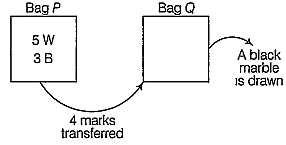 Multiple Choice Questions
Multiple Choice QuestionsFour numbers are chosen at random from{1, 2, 3, ..., 40}. The probability that they are not consecutive, is
If A and B are mutually exclusive events with P(B) 1, then P(A) is equal to(Here is the complement of the event B)
Seven white balls and three black balls are randomly arranged in a row. The probability that no two black balls are placed adjacently is
A student has to answer 10 out of 13 questions in an examination choosing atleast 5 questions from the first 6 questions. The number of choice available to the student is
63
91
161
196
A candidate takes three tests in succession and the probability of passing the first test is p. The probability of passing each succeeding test is p or according as he passes or fails in the preceding one. The candidate is selected, if he passes atleast two tests. The probability that the candidate is selected, is
p2(2 - p)
p(2 - p)
p + p2 + p3
p2(1 - p)
Two persons A and B are throwing an unbiased six faced dice alternatively, with the condition that the person who throws 3 first wins the game. If A starts the game, then probabilities of A and B to win the same are, respectively
3 out of 6 vertices of a regular hexagon are chosen at a time at random. The probability that the triangle formed with these three vertices is an equilateral triangle, is
A bag P contains 5 white marbles and 3 black marbles. Four marbles are drawn at random from P and are put in an empty bag Q. If a marble drawn at random from Q is found to be black then the probability that all the three black marbles in P are transfered to the bag Q
A.

There are 10 intermediate stations on a railway line between two particular stations. The number ofways that a train can be made to stop at 3 of these intermediate stations so that no two of these halting stations are consecutive is
56
20
126
120
If 12 identical balls are to be placed in 3 identical boxes, then the probability that one of the boxes contains exactly 3 balls, is




